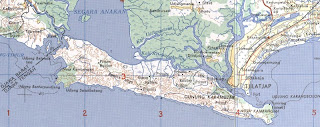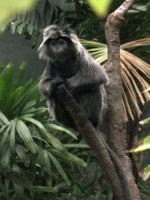 Kambangan ( Kambangan Island )
Kambangan ( Kambangan Island )Geography
Location
South East Asia
Coordinates
7°45′S 108°55′E
Area
121 km²
Administration
Indonesia
Province
Central Java
Demographics
Population
Around 3000 natives, and several hundred inmates
Indigenous people
Javanese
Kambangan (also Nusa Kambangan, Nusakambangan or Nusa Kembangan) island is located in the Indian Ocean, separated by a narrow strait off the southern coast of Java island; the closest port is Cilacap in Central Java province. Dubbed as the "Alcatraz of Indonesia", the island is notorious for its maximum security prisons, home to convicted murderers, terrorists, drug dealers and those convicted in high profile corruption cases.
History
The island was made into a prison island during the Dutch period. The colonial government built a high security prison on the isolated island to exile criminals and political dissidents. The prison on Nusakambangan was opened in the mid-1920s by Indonesia's former Dutch colonial rulers and was once considered the harshest penal institution in South East Asia. The island was declared off-limits in 1905 by the Dutch.
Its usage as a prison island continued after independence. During the rule of former President Suharto, hundreds of political dissidents were imprisoned on the island. Most were political prisoners, members of the banned Communist Party of Indonesia.
In 1996 the island was finally opened to the public as a tourist destination.
In 1996 the island was finally opened to the public as a tourist destination.
The island has also been involved in refugee handling. About 140 Afghan refugees were detained on the island after their boat, which was en route to Christmas Island, Australia, sank in rough seas on August 17, 2001. However, more than 90 of these refugees would later escape in September 19, 2001, sailing away in small fishing boats and are believed to be have headed for Australia. The island was also affected by the July 2006 Java earthquake, when a tsunami triggered by a 7.7-magnitude undersea earthquake off the coast of Java. At least 11 villagers diappeared and 8 people killed in the aftermath, two of which are prisoners in Permisan prison. And at least fifteen inmates on the Nusakambangan prison island near Pangandaran were also missing.
Geography and nature
Javan Lutung, one of primates found in Nusakambangan .
Nu sakambangan is separated from Java island by the narrow Segara Anakan strait. Being isolated from the mainland Java, the island is relatively under-developed and less inhabitated in which wildlife is still kept preserved. The eastern side to a bay is a nature reserve area where an old Dutch fortress is located on the Karangbandung beach. As a lowland tropical rain forest, Nusakambangan is biologically diverse. Although the island area is only 17,000 hectares (or one-thousandth of the Java island), it is the habitat of one-tenth of Java's flora.
sakambangan is separated from Java island by the narrow Segara Anakan strait. Being isolated from the mainland Java, the island is relatively under-developed and less inhabitated in which wildlife is still kept preserved. The eastern side to a bay is a nature reserve area where an old Dutch fortress is located on the Karangbandung beach. As a lowland tropical rain forest, Nusakambangan is biologically diverse. Although the island area is only 17,000 hectares (or one-thousandth of the Java island), it is the habitat of one-tenth of Java's flora.
More than 71 different bird species, 14 reptile species and various mammal species are found in the island. Twenty-three bird species are in the protected status including Kuntul Karang (Egretta sacra), Black Egret (Ciconia episcopus), Bangau Tongtong (Leptoptilos javanicus), white-bellied sea eagle (Haliaeetus leucogaster), elang bondol (Haliastur indus), and elang bido (Spilornis cheela). Several other protected mammal species include the black-spotted leopards (Panthera pardus), Javan Muntjac (Muntiacus muntjak) and Javan mouse deer (Tragulus javanicus). Four of six endemic primates in Java, namely Javan Lutung (Trachypithecus auratus), the crab-eating Macaque (Macaca fascicularis), Javan Surili (Presbytis comata), and kukang (Nyctibus sp.), have been reported to live on the island.
 sakambangan is separated from Java island by the narrow Segara Anakan strait. Being isolated from the mainland Java, the island is relatively under-developed and less inhabitated in which wildlife is still kept preserved. The eastern side to a bay is a nature reserve area where an old Dutch fortress is located on the Karangbandung beach. As a lowland tropical rain forest, Nusakambangan is biologically diverse. Although the island area is only 17,000 hectares (or one-thousandth of the Java island), it is the habitat of one-tenth of Java's flora.
sakambangan is separated from Java island by the narrow Segara Anakan strait. Being isolated from the mainland Java, the island is relatively under-developed and less inhabitated in which wildlife is still kept preserved. The eastern side to a bay is a nature reserve area where an old Dutch fortress is located on the Karangbandung beach. As a lowland tropical rain forest, Nusakambangan is biologically diverse. Although the island area is only 17,000 hectares (or one-thousandth of the Java island), it is the habitat of one-tenth of Java's flora.More than 71 different bird species, 14 reptile species and various mammal species are found in the island. Twenty-three bird species are in the protected status including Kuntul Karang (Egretta sacra), Black Egret (Ciconia episcopus), Bangau Tongtong (Leptoptilos javanicus), white-bellied sea eagle (Haliaeetus leucogaster), elang bondol (Haliastur indus), and elang bido (Spilornis cheela). Several other protected mammal species include the black-spotted leopards (Panthera pardus), Javan Muntjac (Muntiacus muntjak) and Javan mouse deer (Tragulus javanicus). Four of six endemic primates in Java, namely Javan Lutung (Trachypithecus auratus), the crab-eating Macaque (Macaca fascicularis), Javan Surili (Presbytis comata), and kukang (Nyctibus sp.), have been reported to live on the island.
Demographics
The island population is 3,000, excluding the prison inmates and staff; most inhabitants are Javanese. Their main occupation is fishery and some work in rubber and teak plantations. However, illegal logging activities, mostly conducted by outsiders, threaten the island environment. Such activities have resulted in a vast critically threatened land area of approximately 3,000 hectares.
There are nine prisons built in the island, four of which are still used:
Permisan prison, built in 1908,
Batu prison, built in 1925,
Besi prison, built in 1929,
Kembangkuning prison, built in 1950.
There are also five inactive prisons:
Nirbaya prison, built in 1912,
Karanganyar prison, built in 1912,
Karangtengah prison, built in 1928,
Gliger prison, built in 1929,
Limusbuntu prison, built in 1935.
All of these were built by Dutch, except Kembangkuning prison, which was built after independence. Of these, Batu prison is considered the most famous.
Notorious inmates
Famous people once imprisoned on the island include:
Pramoedya Ananta Toer, poet and novelist, jailed as political prisoner.
Bob Hasan, former Minister of Forestry, convicted of corruption charges,
Imam Samudra, Amrozi, and Ali Gufron, three men convicted of organising the 2002 Bali bombing. They were expected to be executed there.
Tommy Suharto, son of former president Suharto, convicted of masterminding the murder of the judge who sentenced him for corruption.
Fabianus Tibo, Dominggus da Silva and Marianus Riwu, three men convicted as provocateurs of a deadly riot in Central Sulawesi; they have been excecuted there. Nusakambangan has also held hundreds of members of Gerakan Aceh Merdeka, but they were later released as part of a peace deal.
Pramoedya Ananta Toer, poet and novelist, jailed as political prisoner.
Bob Hasan, former Minister of Forestry, convicted of corruption charges,
Imam Samudra, Amrozi, and Ali Gufron, three men convicted of organising the 2002 Bali bombing. They were expected to be executed there.
Tommy Suharto, son of former president Suharto, convicted of masterminding the murder of the judge who sentenced him for corruption.
Fabianus Tibo, Dominggus da Silva and Marianus Riwu, three men convicted as provocateurs of a deadly riot in Central Sulawesi; they have been excecuted there. Nusakambangan has also held hundreds of members of Gerakan Aceh Merdeka, but they were later released as part of a peace deal.
Tourism
From the mid-1990s, the island was intermittently promoted by local authorities as a tourist destination, primarily for its caves, beaches, and unusual wildlife that is extinct on Java. Notable attractions include Permisan beach (pantai Permisan) with its beautiful white and gray sands near the Permisan jail lighthouse, Ranca Babakan on the west coast of the island, White Sands beach (Pantai Pasir Putih), and several caves such as Queen's cave (Goa Ratu). According to the Cilacap Tourism Office, Nusakambangan was opened as a tourist destination following an agreement between the Central Java Governor and Ministry of Justice in 1996. The Cilacap government then invested some Rp 1.7 billion in preparations for the opening up of the island, most of which was used on the construction of tourist-related infrastructure. A special agency (BPOW) was also established to manage tourism on the island, with the Nusakambangan Prison warden made head of the agency and Cilacap Tourism Office chief as the deputy. One of the main cultural events is Sedekah Laut (sea sacrifice), which is held by the Surakarta Sultanate every new year in the Javanese calendar.